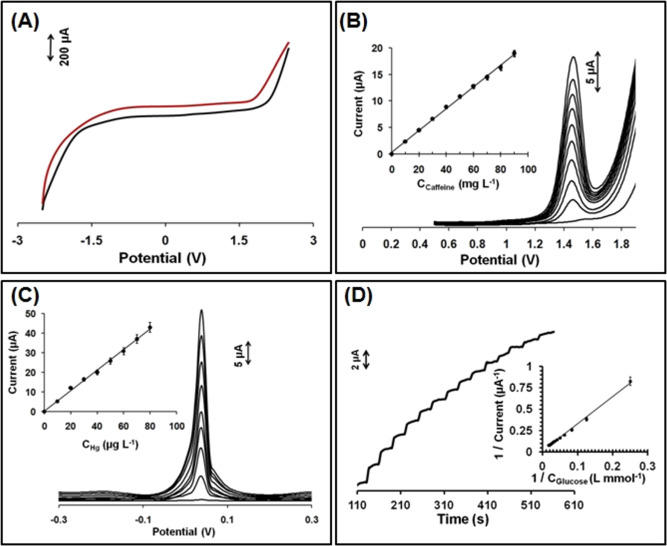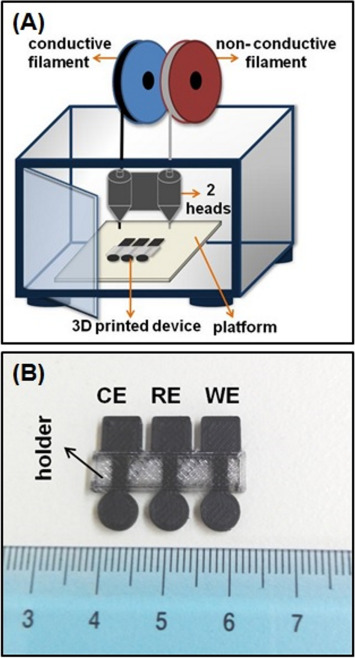University of Athens Researchers 3D Print Electrochemical Sensing Platform, Testing with Caffeine & Mercury
Greek researchers are 3D printing new sensors for important detection applications, outlined in their recently published paper, ‘Single-step fabrication of an integrated 3D-printed device for electrochemical sensing applications.’ Authors Vassiliki Katseli, Anastasios Economou, and Christos Kokkinos, all from the University of Athens, have employed the myriad benefits of 3D printing to create an electrochemical sensing platform designed in Tinkercad, using a Flashforge Creator Pro 3D printer (featuring two print heads), and PLA filament.
With a focus on integration and mobility, the authors created an entirely 3D printed three-electrode device that works independently of external electrodes and can easily be transported to and used on site for analysis of different chemical factors. They chose this type of fabrication over more conventional methods after reviewing multiple research studies using:
- Screen printing and ink-jet printing – found to be less desirable methods due to the amount of maintenance and control, and extra treatment required of the materials for necessary conductivity and electroanalytical performance.
- Microengineering – too expensive and requiring equipment and materials that are unwieldy and high maintenance.
- Injection molding – requiring expensive molds.

(A) Schematic illustration of the 3D-printing process using a 3D printer equipped with two heads. (B) Photograph of the 3D-printed integrated device.
Not only was this simple new device created quickly and affordably via 3D printing, the authors were able to do so in one step due to a double print head and PLA both in conductive (with a carbon/PLA composite) and non-conductive form. Initial testing was performed as they attempted to detect caffeine, with success:
“The 3D printed device exhibited well-shaped DPV peaks of caffeine in the studied concentration range (0–90 mg L−1 of caffeine) and the peak currents were linearly related to the concentration (R2 = 0.998) (Fig. 2B); this range of concentrations is relevant to most food, pharmaceutical and beverage samples containing caffeine.”
The researchers also measured mercury with the device:
“The LOD was 1.9 μg L−1 and the calibration plot exhibited satisfactory linearity in the studied concentration range (R2 = 0.996). The calculated limit of quantification (LOQ) allows determination of Hg(II) at the level recommended by WHO [29] (i.e. 6 μg L−1) but, at present, does not fulfill the lower requirements of EPA or the EU which necessitate the use of Au-modified electrodes [10,30]. The between-measurement % RSD is 5.6% (8 measurements at the same sensor) and the between-device % RSD is 8.3% (single measurements at 4 different sensors) at the 40 μg L−1 Hg(II) level. The voltammetric response of the 3D-printed device remained statistically constant for at least 30 continuous ASV measurements cycles (duration of 3 h).”
The team was able to create a design that even ‘an inexperienced user’ would be able to complete quickly, featuring a simple geometry and a sensor meant to fit any type of traditional electrochemical cell. The device is environmentally friendly, re-usable, and ‘semi-disposable.’ The platforms could also be easily used in a teaching setting or any other lab.
Further progress is being made to improve performance with use of the following:
- Biomolecules other than enzymes
- Electron-transfer mediators
- Metal films
- Permselective coatings
“The operational potential range achieved with the 3D-printed sensor was similar, or better than, other carbon electrodes while the manufacturing reproducibility (between-device RSD% < 10%) was satisfactory. The existing design can be readily extended to more complex geometries involving multiple working electrodes for multiplexed sensing,” concluded the researchers.
3D printing technology lends itself well to the integration of electronics, and scientists, engineers, designers, and many different users have developed sensors suitable for a variety of applications—from biosensors to electrodes and much more. Find out more about how 3D printing can further electrochemical sensing applications here.
What do you think of this news? Let us know your thoughts! Join the discussion of this and other 3D printing topics at 3DPrintBoard.com.

(A) Schematic illustration of the 3D-printing process using a 3D printer equipped with two heads. (B) Photograph of the 3D-printed integrated device.
Subscribe to Our Email Newsletter
Stay up-to-date on all the latest news from the 3D printing industry and receive information and offers from third party vendors.
Print Services
Upload your 3D Models and get them printed quickly and efficiently.
You May Also Like
Reinventing Reindustrialization: Why NAVWAR Project Manager Spencer Koroly Invented a Made-in-America 3D Printer
It has become virtually impossible to regularly follow additive manufacturing (AM) industry news and not stumble across the term “defense industrial base” (DIB), a concept encompassing all the many diverse...
Inside The Barnes Global Advisors’ Vision for a Stronger AM Ecosystem
As additive manufacturing (AM) continues to revolutionize the industrial landscape, Pittsburgh-based consultancy The Barnes Global Advisors (TBGA) is helping shape what that future looks like. As the largest independent AM...
Ruggedized: How USMC Innovation Officer Matt Pine Navigates 3D Printing in the Military
Disclaimer: Matt Pine’s views are not the views of the Department of Defense nor the U.S. Marine Corps Throughout this decade thus far, the military’s adoption of additive manufacturing (AM)...
U.S. Congress Calls Out 3D Printing in Proposal for Commercial Reserve Manufacturing Network
Last week, the U.S. House of Representatives’ Appropriations Committee moved the FY 2026 defense bill forward to the House floor. Included in the legislation is a $131 million proposal for...


































